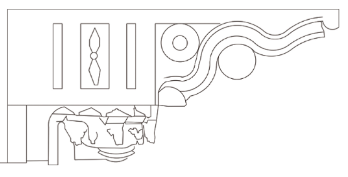“The trabeated construction system suggests the work of local, indigenous craftsmen. This was rare in the Mughal era when the essential style of the building underwent a change and craftsmen had shifted elsewhere. This mosque is one of the very few extant brick and timber mosques in Gujarat..”

The masjid is located at Tankshal Ni Pol in Kalupur Ward, towards the eastern side of the Old City of Ahmedabad. The word ‘Tankshal’ literally translates to ‘Mint’ – the Tankshal road separates the Tankshal Ni Pol from the area that historically housed the Old Mint and is known for important heritage structures like the Tankshal Ni Haveli. From the exterior, the Masjid is observed to be a brick masonry structure plastered originally with lime plaster (cement plaster seen in some places). On entering inside through a cusped arch doorway, the entrance area opens into a courtyard. Only from this courtyard can we observe the hypo-style prayer hall (Jamat Khana) – a composite structure of timber posts and beams (supported by wooden brackets) surrounded by the brick and mud mortar masonry wall, that rests upon a carved stone plinth. The hall on the first floor is topped by timber roofing members and a corrugated pitched roof. One can find clues to a different past in the remnants of building elements from before, such as – stone pillar bases on the first floor that possibly indicate a previously different roofing style.; pillar bases and masonry projections above the ablution tank suggest that a sloping roof may have existed over it; pillar bases buried in the additional flooring done in the Jamat Khana.
We can also observe that this Mosque is an example of a Masjid that was meant for the use of a small community and daily individual prayers from the presence of mihrabs (prayer niches) but lack of minbar (pulpit). Although much of the iconic Islamic architecture of Ahmedabad developed under the patronage of the Sultans in the Sultanate period; a close look at the Islamic buildings in Kalupur shows that most of these including the Tankshal Ni Pol Masjid were constructed during the Mughal period. It’s possible to arrive at this conjecture about the origins (most probably constructed during the Mughal period in Ahmedabad) of the masjid’s architectural style when one observes the evolution of Islamic architecture in Ahmedabad. From the period between Mahmud Begada’s reign starting in 1458 up to the decline of the Mughal era in Ahmedabad around 1707, several stylistic changes are observed. Integration of arcuate and trabeate styles and the advent of brick as a construction material for building mosques and tombs. The use of stone as an accepted material for the construction of mosques, declined during this period, resulting in a shift in the essential architectural style. These changes are indicative of the emergence of mosques like the Tankshal Pol Masjid. The trabeated construction system suggests the work of local, indigenous craftsmen. This was rare in the Mughal era when the essential style of the building underwent a change and craftsmen had shifted elsewhere. This mosque is one of the very few extant brick and timber mosques in Gujarat. Such mosques generally deteriorated more rapidly than their stone counterparts and tended to be almost entirely rebuilt. This explains why so few Islamic buildings of this type have survived to date. 10th February 2021
.jpg)








Comments